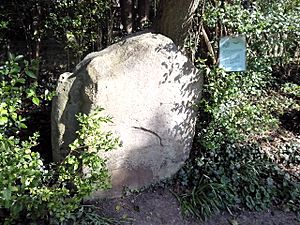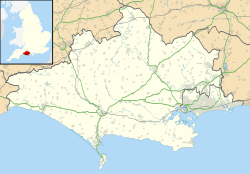Flagstones Enclosure facts for kids

The "Druid Stone" found at Thomas Hardy's house in 1891, now identified as a sarsen stone from Flagstones Enclosure
|
|
| Region | Dorset, England |
|---|---|
| Coordinates | 50°42′25″N 2°25′12″W / 50.707°N 2.420°W |
| Type | Causewayed enclosure |
| History | |
| Periods | Neolithic / Bronze Age |
Flagstones is an ancient site near Dorchester, Dorset, England. It was built a very long time ago, during the late Neolithic period (the New Stone Age). It's a special type of circular area with ditches that aren't continuous, like a broken ring.
The site is called Flagstones because it was found under a house named Flagstones House, which is now gone. About half of this ancient site was dug up by archaeologists in the 1980s. This happened when a new road, the Dorchester by-pass, was being built. The other half of Flagstones is still hidden underground, beneath the garden of Max Gate, which was the home of the famous writer Thomas Hardy.
The Mystery of the Druid Stone
In March 1891, workers were digging under the lawn at Thomas Hardy's house, Max Gate. They found a very large stone about three feet (one meter) underground. It was a sarsen stone, which is a type of hard sandstone.
It took seven men using special tools called levers to lift the stone. It had been lying flat in the ground. Around the stone, they found ashes and some bones that were partly burned. Thomas Hardy called this discovery "The Druid Stone." He had it set upright at the edge of his lawn, where it still stands today.
Hardy even wrote a poem about the stone called "The Shadow on the Stone." For a long time, no one knew where the stone came from. It was only when the Flagstones site was discovered in the 1980s that experts realized this sarsen stone was part of a much larger ancient monument.
Digging Up the Past: Excavations
About half of the Flagstones site was carefully dug up by archaeologists in 1987 and 1988. The part of the site that was under Flagstones House was excavated by a group called Wessex Archaeology. After the digging, that area was completely removed to make way for the deep cutting of the Dorchester by-pass road. The other half of the ancient site remains untouched under the grounds of Max Gate.
The Flagstones site was made up of a circular ring of pits. These pits were not evenly spaced. They were built during the late 4th millennium BC, which is over 5,000 years ago. The chalk walls of some of these pit sections had special designs carved into them. These carvings were probably made using sharp flint tools.
Archaeologists made some interesting discoveries in the ditches. They found the remains of an adult who had been cremated (burned). They also found two children who had been buried whole. Each of these burials was placed at the bottom of a ditch section, under a slab of sandstone or sarsen stone.
Later, during the Early Bronze Age, a young man was buried in a small mound, called a tumulus, right in the center of the Flagstones site. Scientists used carbon dating to figure out the age of these remains. They found that the Flagstones site was built between 3486 BC and 2886 BC. The central burial of the young man happened about a thousand years later. It seems that this central mound later became a popular spot for making flint tools.
Flagstones is not the only ancient site in the area. A large henge enclosure called Mount Pleasant henge is located about 500 meters (about a third of a mile) to the east. Another important site, Maumbury Rings, is about 1500 meters (nearly a mile) to the west.


